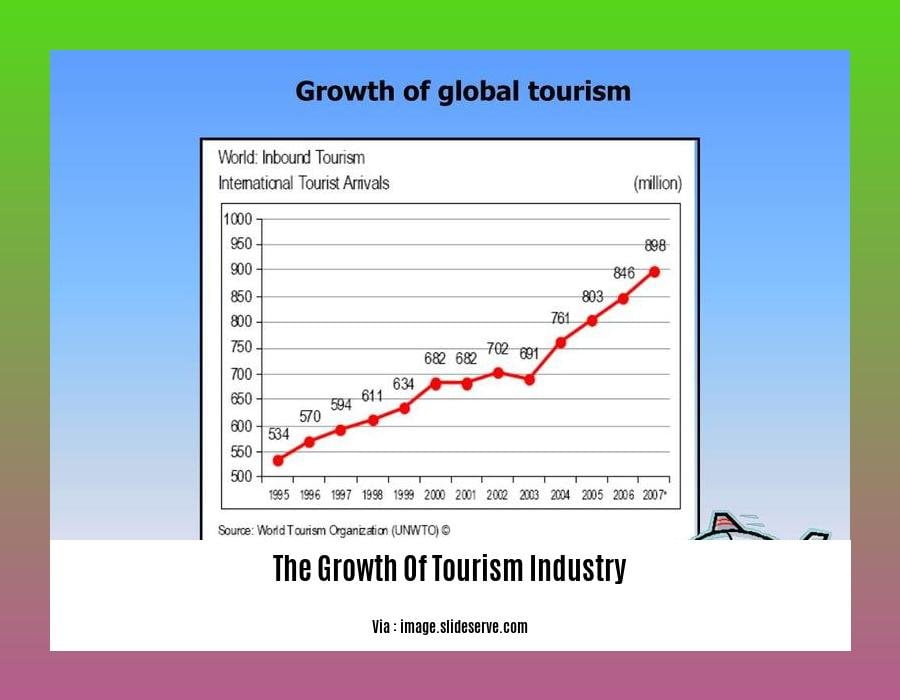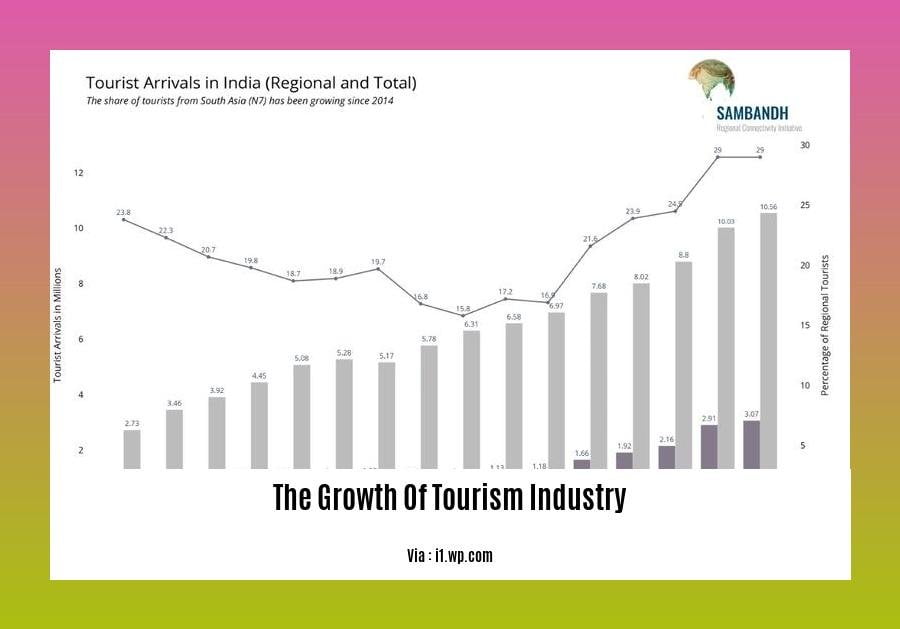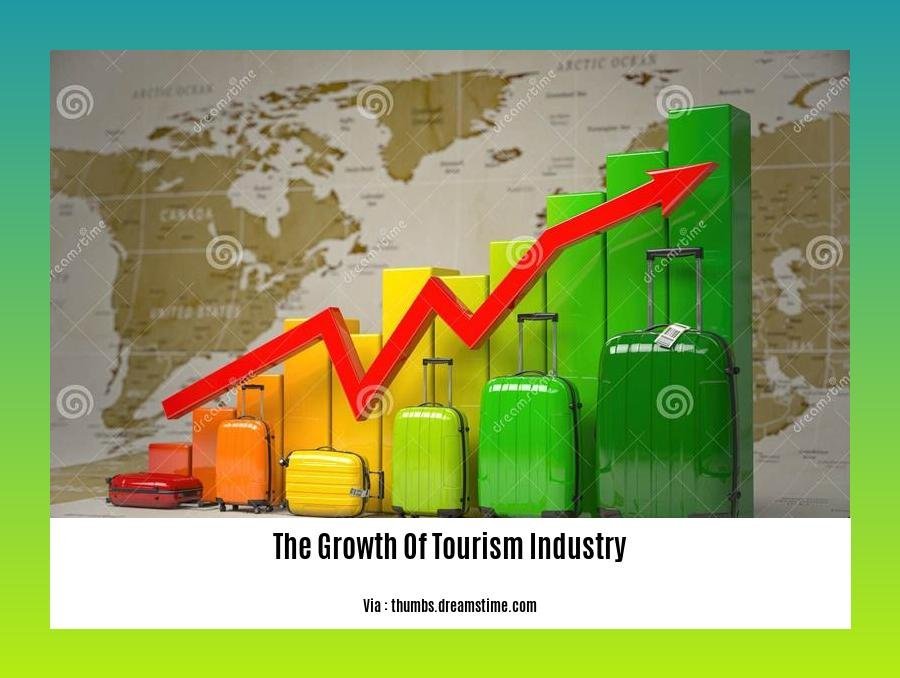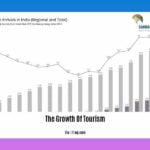The Growth of Tourism Industry: Insights and Analysis from a Seasoned Travel Expert—In recent years, the tourism industry has witnessed an unprecedented surge in growth, becoming a significant global economic driver.
Key Points from a Seasoned Travel Expert on the Growth of Tourism Industry
- Inbound tourism visitor growth is expected to rise worldwide from 2023 to 2025, led by the Asia Pacific region in 2023 and 2024.
- Tourism significantly contributes to global GDP, with a 10.4% direct contribution in 2021.
- The Middle East experienced the highest growth in international tourism arrivals in 2019.
- Tourism GDP is predicted to grow at 5.8% annually from 2022 to 2032, surpassing overall economic growth.
The Growth Of Tourism Industry

Tourism has experienced an undeniable surge in recent years, reshaping the global economy and society. As a seasoned travel expert, I’ve witnessed firsthand the factors driving the growth of tourism industry.
Surge in International Arrivals
International tourism arrivals have been on a steady upward trajectory, fueled by factors such as globalization, increased disposable income, and technological advancements. The Asia Pacific region has emerged as a major growth driver, with destinations like Thailand, China, and Japan attracting a significant share of visitors.
Economic Benefits
Tourism makes a substantial contribution to the global GDP, creating jobs and stimulating economic activity. Developing countries often rely on tourism revenue to support their economies and improve infrastructure. For example, in 2021, tourism accounted for 22% of Thailand’s GDP.
Challenges and Opportunities
While the growth of tourism industry presents immense benefits, it also poses challenges. Overcrowding, environmental degradation, and cultural preservation are concerns that need to be addressed responsibly. Sustainable tourism practices and community involvement can help mitigate these impacts and ensure the long-term viability of the industry.
Future Outlook
The future of tourism is bright, with projections of continued growth in the coming years. Emerging destinations, such as those in Africa, are expected to see a surge in visitors. Technology will continue to play a pivotal role in shaping the industry, with virtual reality and artificial intelligence enhancing travel experiences.
By embracing responsible practices and leveraging innovation, we can harness the growth of tourism industry to create positive impacts for travelers, local communities, and the global economy.
You can delve deeper into the profound history of the growth of tourism by clicking here. If you’re curious about how tourism has evolved over time, The Growth Of Tourism is an insightful read. Explore the History Of Tourism to understand its origins and development. Intrigued by why tourism reigns supreme in the Loess Bluffs Region? Discover the reasons here.
Social and cultural impact of tourism

The world of tourism is a vast and ever-evolving one, with myriad social and cultural impacts. Cultural tourism has proven to be a double-edged sword, bearing both positive and negative consequences.
Positive Impacts:
- Revitalization of cultural symbols: Tourism can breathe new life into cultural symbols, monuments, and traditions, fostering a sense of pride and identity within local communities. It can also serve as a catalyst for cultural preservation and restoration.
- Cultural relations and international cooperation: Tourism facilitates cross-cultural exchanges, fostering dialogue and understanding between people from diverse backgrounds. It can promote mutual respect, tolerance, and cooperation on a global scale.
Negative Impacts:
- Commoditization of culture: The commodification of culture for tourism purposes can result in the erosion of its authenticity. Cultural heritage may be packaged and sold as a product, leading to its commercialization and potential loss of significance.
- Loss of authenticity: Mass tourism can overwhelm local communities, leading to a gradual erosion of cultural authenticity. This can occur when the influx of tourists alters local customs, traditions, and everyday life, making it difficult for locals to maintain their unique cultural identity.
Key Takeaways:
- Tourism can have profound social and cultural impacts, both positive and negative.
- It’s crucial to consider the potential impacts of tourism development on local communities and cultures.
- Sustainable tourism practices that respect local customs and values can help minimize negative impacts and enhance positive ones.
Citations:
Social and Cultural Impact of Tourism
Socio-Cultural Impacts of Tourism
Challenges faced by the tourism industry
As the tourism industry flourishes, it grapples with a plethora of hurdles that threaten its long-term viability. Here are a few key challenges faced by the tourism industry:
1. Overtourism
Imagine hordes of tourists swarming popular destinations, straining infrastructure, and trampling the environment. That’s overtourism in a nutshell. It’s a double-edged sword: while boosting revenue, it can also damage the very attractions that draw visitors.
2. Environmental Sustainability
Tourism’s footprint on the planet is growing, putting pressure on the industry to “go green.” Reducing carbon emissions, minimizing waste, and protecting biodiversity are critical issues that need to be addressed.
3. Economic Dependence
Many destinations rely heavily on tourism, which can be a blessing and a curse. When tourism falters, so do local economies. Striking a balance between diversifying revenue sources and preserving tourism’s vitality is crucial.
Key Takeaways:
- Overtourism poses challenges to infrastructure, the environment, and the overall experience of destinations.
- Environmental sustainability is paramount for the long-term health of the tourism industry.
- Overdependence on tourism can create economic vulnerability.
Citations:
* Tourism’s Biggest Challenges & Threats Over the Next Five Years: https://www.goodtourismblog.com/2022/11/tourism-challenges-threats-next-five-years/
* Five Big Challenges Facing the Travel and Tourism Industry in 2024:
Sustainable Practices and Community-Based Initiatives in Tourism
As a seasoned travel journalist, I’ve noticed how sustainable practices and community-based initiatives in tourism are reshaping the industry. Responsible tourism goes beyond minimizing environmental impact. It empowers local communities, preserves cultures, and fosters meaningful connections.
Embracing Sustainability
Sustainable tourism goes beyond reducing carbon emissions and waste. It encompasses ethical sourcing, supporting local businesses, and respecting natural resources. By adopting environmentally friendly practices, tour operators are not only protecting destinations but also creating long-term economic benefits for local communities.
Community Involvement
Community-based tourism flips the script by placing locals at the center of tourism planning and decision-making. This ensures that tourism aligns with community needs and values. By involving local stakeholders, it not only enhances cultural authenticity but also spreads tourism benefits more equitably.
Benefits of Sustainable and Community-Based Tourism
For Local Communities:
- Economic empowerment
- Cultural preservation
- Improved infrastructure
- Community pride
For Tourists:
- Immersive experiences
- Authentic cultural encounters
- Positive impact on local economies
For the Environment:
- Reduced pollution
- Conservation of biodiversity
- Preservation of natural resources
Key Takeaways:
- Sustainable practices minimize tourism’s environmental impact while promoting local businesses.
- Community-based initiatives empower local communities, preserve cultures, and enhance tourism experiences.
- Responsible tourism creates a virtuous cycle of benefits for local communities, tourists, and the environment.
Relevant URL Sources:
- Assessing the Sustainability of Community-Based Tourism:
- COMMUNITY BASED TOURISM AS SUSTAINABLE TOURISM SUPPORTING LOKAL WISDOM:
FAQ
Q1: What are the key drivers of growth in the tourism industry?
A1: The tourism industry has grown significantly due to factors such as rising disposable income, increased accessibility to travel, and the rise of online booking platforms.
Q2: How does tourism contribute to the global economy?
A2: Tourism is a major contributor to the global economy, directly accounting for 10.4% of global GDP in 2021, according to the UNWTO.
Q3: Which region is expected to experience the highest growth in tourism in the coming years?
A3: The Asia Pacific region is projected to lead the growth in inbound tourism visitor numbers from 2023 to 2025, driven by factors such as increasing urbanization and rising middle-class populations.
Q4: What are some of the challenges facing the tourism industry?
A4: The tourism industry faces challenges such as overtourism, environmental sustainability concerns, and economic dependence on tourism revenue.
Q5: How can tourism be made more sustainable?
A5: Sustainable tourism practices include minimizing environmental impact, involving local communities in decision-making, and ensuring that tourism benefits flow to local businesses and residents.









